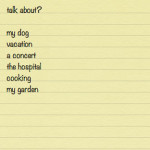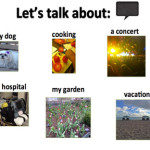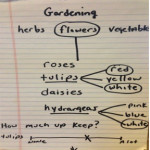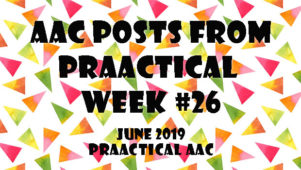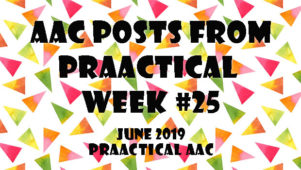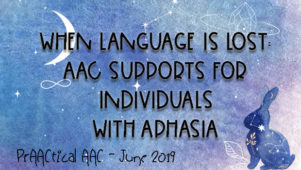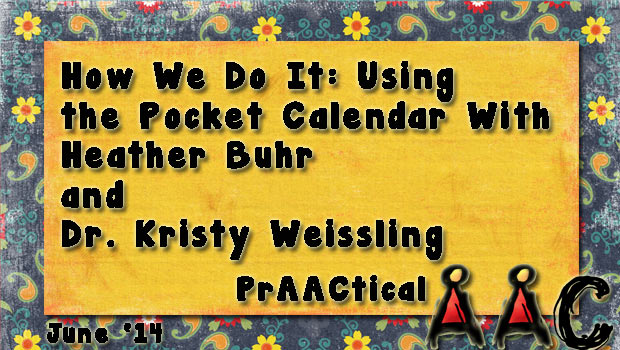Aphasia, Supported Communication, Written Choice Strategy, + Variations
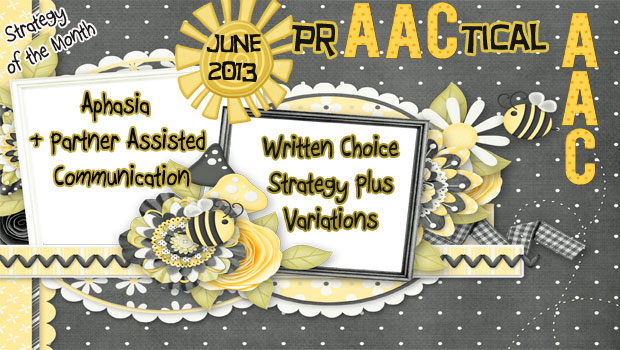
This month, we have enjoyed writing about communication strategies for aphasia. Partner supported communication is the platform for many of the effective techniques we use to help people with aphasia initiate, maintain, or terminate communication and conversation. We have talked about assessment strategies, communication books, and alphabet & topic supplementation. Now it is time to discuss the written choice strategy. The written choice strategy is fairly easy to implement, can look natural, and can result in seamless detailed conversation. Written choices are provided in the context of conversation and are displayed in an organized manner.
What is It?
The written choice strategy has the partner/facilitator generating written key-word choices that relate to the conversational topic. The written choices can be paired with text, pictures, drawings, symbols, and natural speech. The partner/facilitator writes possible answers to conversational questions in list form. The conversation is extended as continued written choices are offered for follow-up questions and ideas. There are many variations that can be applied to this strategy by using rating scales, maps, brochures, books, etc. to allow the person with aphasia to delineate preferences, emotions,amounts, and other relevant conversational information.
Who is it For?
The written choice strategy is for communicators at the partner dependent level. This includes emerging, conversational choice, and transitional communicators.
Implementation
The topic can be decided by the partner facilitator and written down at the top of a page of paper. You can use a regular notebook, notepad, or just a piece of paper. We often like using a notebook because it can later be used to refer to later if the same topics are discussed. Also, when you have a notebook, there are many times that the person with aphasia will spontaneously go back to initiate a topic of preference and use the book as a type of self-made communication book (and we love this). However, if the conversation is happening on the ‘fly’ and you do not have a notebook, all you need is something to write on and a writing utensil (e.g., paper & pen, notepad app and keyboard).
A variation from the written choice strategy about topic is rather than the partner always choosing the topic, the written choice can begin with topic. Since conversation is a two-way street, there are times you will want to use the written choice strategy to let the person with aphasia decide the topic to talk about. A few topics can be listed and the facilitator can begin by asking ‘what do you feel like talking about?’
In either case, once the topic is decided, the topic is listed at the top of the page, and then partner focused questions about the topic dictate a set of anticipated answers. The anticipated answers are then written down. The written choices can be provided as a list or in some other type of graphic organizer format. The person with aphasia then answers by pointing to their choice. There is always the possibility that none of the anticipated answers/choices are appropriate, and although this does not happen often, you may want offer a standard choice that indicates “none of the choices are appropriate, offer some others”.
There are many variants within the written choice strategy. The idea is to offer written choices in order to allow the person with aphasia communicate preferences, thoughts, desires, or information. Some variations of using written word choices are to use rating scales for qualitative answering (e.g., how much, how fair, how hard/easy, etc.). Maps or brochures can be used to answer specific questions about places or events.
Conversation is extended by having the partner/facilitator contribute information to the conversation as well as asking follow-up relevant questions. The conversation continues until it comes to a natural end and there are no more follow-up questions to ask or one of the conversational partners indicate they want to be done talking about the topic. With this in mind, make sure there is some AAC way for the person with aphasia to indicate they want to switch or terminate topics.
The written choice strategy definitely can branch out to using a variety of visual supports to provide linguistic structure that lessens the need for open-ended word retrieval and allows for more spontaneous contributions to the conversation.
Quick Start
Do This
- Find out several personal topics of interest by interviewing family or showing a variety of photos or remnants and seeing which ones bring about a response
- Decide a topic to discuss
- Get a marker and notebook/notepad
- Ask a natural question about the topic and write down several possible answers
- Show how to point to a choice if needed
- Circle the choice
- Add a natural response to the conversation
- Then ask a natural follow-up question and provide another set of written possible answers
- Continue with partner focused questions until the topic is exhausted
- Remember that teaching and prAACtice is sometimes necessary for this strategy to be effective
- Do a summary of the conversation by re-looking at the flow of written conversation and if it is part of a therapy session, write the main parts as a narrative for later discussion
Not This
- Do not ask yes/no questions (okay, 1 or 2 might be ok)
- Don’t worry about the writing or organization being super neat
- Don’t forget to contribute partner information to the conversation before just asking question after question (it is not a test)
- Don’t forget that it is okay to use drawings or images to support text
- Don’t forget it is okay to accept any type of appropriate response such as gesture, natural speech, etc. If these responses are understood, there is no need for the person with aphasia to also point to the ‘answer’ (again, not a test)
- Don’t forget that this strategy may need to be taught and prAACticed
- Don’t forget to be flexible: if the topic diverges it is fine to go with it.
- Don’t forget to have fun & make the conversation as natural as possible. Many times you will learn interesting and unexpected information from the person.
Further Information:
Lasker, J. P. & Garrett, K. L. (2008, June 17). Aphasia and AAC : Enhancing Communication Across Health Care Settings. The ASHA Leader.
Lasker, J., Hux, K., Garrett, K., Moncrief, E., & Eischeid, T. (1997). Variations on the Written Choice communication strategy for individuals with severe aphasia. Augmentative and Alternative Communication, 13, 108–116.
Aphasia Institute- Communication Tools: Communicative Access & SCA ™
Filed under: Strategy of the Month
Tagged With: aphasia, rating scales, Supported Communication, written choice strategy
This post was written by Robin Parker
